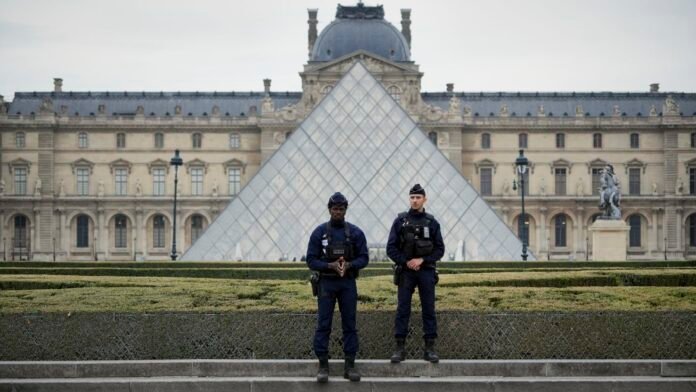Only two days before, on October 19th, 2025, a group of audacious robbers shattered the peace of the iconic Louver Museum in Paris. In broad daylight, shortly after opening hours, a speedy heist, which lasted only minutes, was carried out, with the crooks leaving with priceless objects from the French Crown Jewels. The audacity has sent shockwaves through the art world, reminding everyone that no matter how fortified the cultural citadel, there are audacious criminals that test it.
This article unpicks the action of this most recent robbery, looks at the loot stolen, and follows the Louver’s extensive history of thefts to illustrate how these events have contributed to making one of the world’s most fantastic museums.
The Dumbfounding 2025 Robbery: Timeline of Events
The Louver was targeted by thieves on a Sunday morning rush hour, approximately 9:30 a.m. CET, barely 30 minutes after the museum opened. They struck the Galerie d’Apollon, an extravagant hall famous for its rich ceilings and historical exhibits. The whole heist took only six to seven minutes, surprising staff and security.
As the thieves smashed the glass display cases, the security alarms sounded, but it was after the thieves escaped with the stolen items. The museum was immediately closed, locking the doors to clear the area for investigation until the end of day and all day the following Monday. Police found the tools that the thieves discarded after the robbery; including angle grinders, a blowtorch, some gas, gloves, a walkie-talkie, and a blanket, indicating that the thieves had a getaway planned.
The French authorities moved quickly. President Emmanuel Macron called the robbery “an attack on our heritage,” promising that the stolen items would be recovered, and the perpetrators would face justice. Interior Minister Laurent Nuñez called it a “grand larceny” of invaluable worth, while Justice Minister Gérald Darmanin decried the manner in which the robbery occurred, stating that it put “a bad face on France.” Minister of Culture Rachida Dati also remarked on the professionalism of the thieves, as evidenced by their actions in the CCTV footage, having walked through the museum without injuring anyone.
The theft is the largest at the Louver in 27 years, since the loss of a small painting in 1998. It is during a rash of break-ins at museums that have ransacked institutions across France, as evidenced by the Adrien Dubouche Museum, which was hit in September 2025, and other institutions in 2024.
The Stolen Treasures: Priceless French Crown Jewels
The thieves targeted nine pieces of the French Crown Jewels, a collection of dazzling jewels representing centuries of royal heritage. Among them are diadems, necklaces, earrings, and brooches, all of “incalculable” value according to the French Ministry of Culture. The most celebrated piece in the gallery, the over-$60-million Regent Diamond, remained untouched, maybe too perilous or not on their agenda.
The thieves, in their rush, dropped the Crown of Empress Eugénie, a breathtaking mid-19th-century pearl and diamond tiara, which was recovered by the authorities but in pieces. A second jeweled piece also appeared at the site, but the other eight pieces disappeared.
These gems are not merely glittering trinkets; they’re highly charged with history. Designed for French kings and empresses, they weathered revolutions and wars, only to become victims of contemporary criminals. Their loss hurts not just because of the financial loss but because of their cultural heritage.
How the Thieves Executed the Perfect Getaway
Their four perpetrators were disguised as building workers wearing high-visibility vests and balaclavas. They rode Yamaha TMAX motor scooters from the Seine River side, leaving a vehicle-mounted electric ladder, aka a “monte-meuble” in Paris, by the building.
Two of them climbed a ladder to a second-floor balcony, cut through a glass window with chainsaws and a battery grinder, and entered into the gallery. While in there, two of them pointed their tools at the guards, broke two display cases, and took the jewels. The other two positioned outside below on scooters, were prepped to getaway quickly toward the A6 highway.
They attempted to light the basket of the ladder on fire with gasoline before fleeing but were stopped by a mental worker. Questions about the motives for the precise, non-violent action of the thieves, suggest they had insiders or made extensive reconnaissance, and these questions are now an element of the investigation.
The Ongoing Investigation and Immediate Fallout
The Paris prosecutor’s office opened an investigation immediately, deploying 60 investigators under Prosecutor Laure Beccuau. Teams are studying CCTV images of the museum and exit routes, poring over photos of the suspicious van and ladder. Arrests have yet to emerge, and the identity of the thieves is unknown.
Reacting, France intends to double security at all sites of culture. Already ramped up after recent protests, such as the 2024 soup attack against the Mona Lisa, the Louver now comes under scrutiny over weaknesses. This robbery reveals weaknesses in even the world’s most visited museum, which has millions of visitors every year.
A Look Back: The Louver’s History of Thefts
The 2025 robbery is not singular; the Louvre has had a string of high-profile knocks over the years.
The Mona Lisa Heist of 1911
A one-time Louver employee, Vincenzo Peruggia, borrowed Leonardo da Vinci’s treasure in the middle of the night by concealing himself in a closet and sneaking out the next morning with it. Motivated by Italian nationalism, he concealed it for three years before recovering it. The theft catapulted the painting into international fame, making it an international icon. Peruggia did time but became an Italian hero.
World War II Evacuation (1940)
The Disappearance of *Le Chemin de Sèvres* Painting in 1998. The theft occurred during daylight as thieves casually removed Jean-Baptiste Camille Corot’s *Le Chemin de Sèvres* from the frame and left the museum. No one has seen the small landscape since, even after lockdown and fingerprinting attempts. Other incidents highlight ongoing difficulties, such as a jewel heist in 1966 in transit. Such incidents have prompted security enhancement after each event.
The 1998 Painting Disappearance
Thieves removed Jean-Baptiste Camille Corot’s *Le Chemin de Sèvres* from its frame in the daylight and got away scot-free. The small landscape, concealed easily, has never been seen again after a lockdown and fingerprint sweep.
Other occurrences, such as a 1966 jewel heist in transit, highlight perpetual threats. Such events have repeatedly precipitated security improvements.
Lessons from the Louver’s Thefts and Future Outlook
Each robbery has forced the Louvre to adapt. Following 1911, security for major works became more aggressive. Following 1998, restoration of the 1980s and 1990s introduced layers such as the Pyramid entrance. And now, following the 2025 break-in, the currently underway “Louvre New Renaissance” project plans even more robust security.
But robbers evolve as well, leveraging technology and camouflage. This recent crime underscores the imperative of eternal vigilance in maintaining global cultural heritage.
Conclusion
The 2025 Louver Museum heist is a grim reminder of art’s vulnerability in the face of its beauty. From the disappearance of the Mona Lisa more than a century ago to this new jewel heist, these episodes combine mystery, history, and human creativity—both criminal and security. As authorities search for the stolen treasures, the world waits anxiously, expecting recovery and more effective protection. Ultimately, such episodes only add to appreciation for the priceless gems that define civilization.











